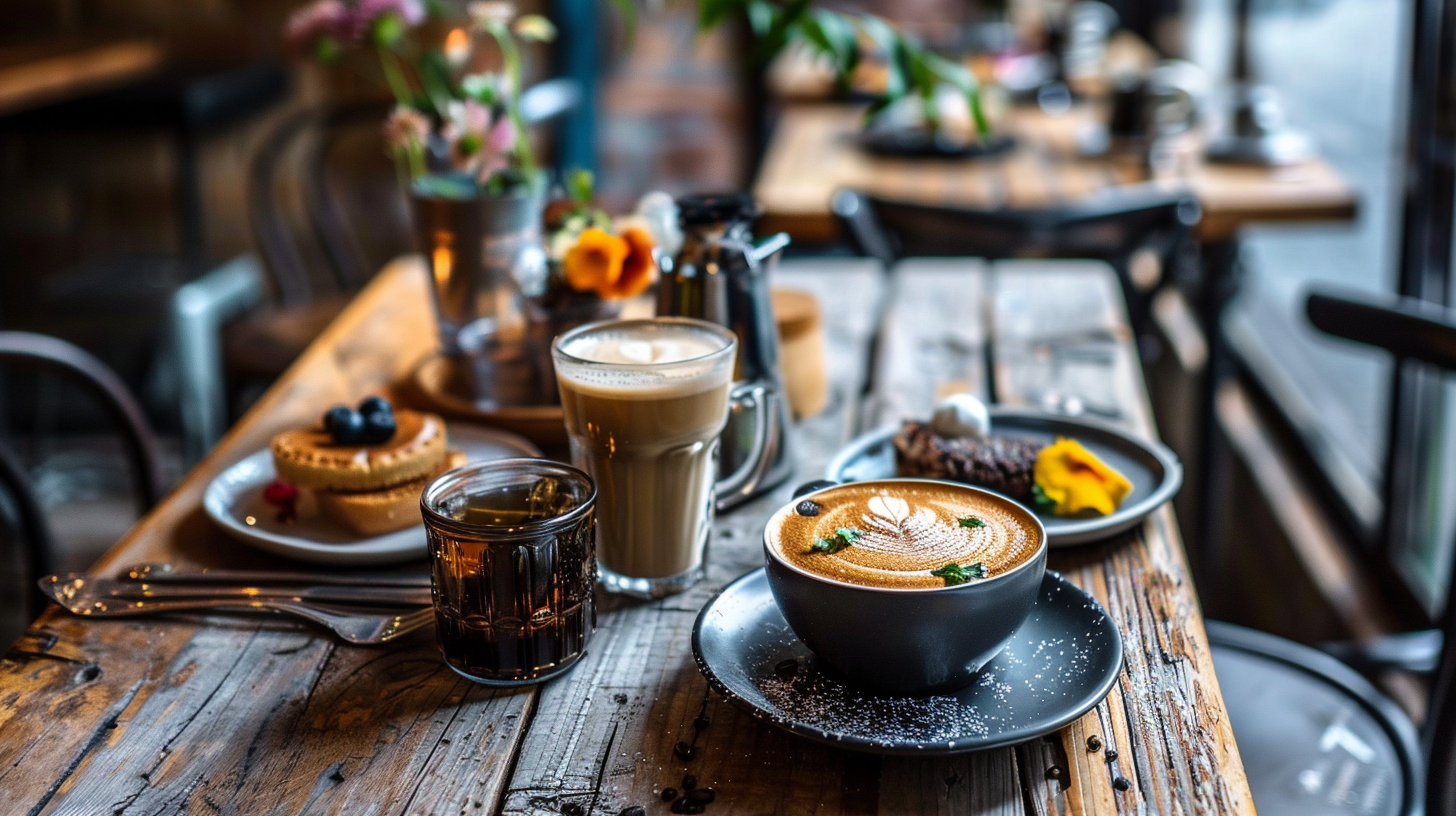Key points
• Lighting: Good lighting is key for showing off the rich textures and vibrant colors of cafe dishes. Natural light usually works best to snap photos that look beautiful and true-to-life. If you need to, though, artificial lights can work to either recreate the look of natural light or to set a particular vibe.
• Composition: How you arrange the food, dishes, and stuff in the background can really make a photo tell a story and stir up emotions. If you make use of some classic photography tricks like the rule of thirds, leading lines, or framing, you’ll probably find your cafe food shots are way more striking.
• Styling: The way food is plated, including which dishes and utensils are chosen, as well as the finishing touches like garnishes, is super important for getting that perfect food photo. Little details and picking colors that go well together can help your dish pop and seem super tempting.
Contents
- Key points
- What is Cafe Food Photography?
- Changes in Food Photos and Their Value for Coffee Shops
- Overview of the Book’s Approach and Structure
- Taking Photos in a Cafe
- Snapping the Cafe Feel
- Sharing a Story With Food and Scenery
- Understanding Lighting in Cafe Environments
- Choosing the Right Camera Settings and Lens for Food Photos
- How to Take Better Photos in Cafes
- The Role of Food Styling in Cafes
- Props and Tableware for better Cafe Food Photography
- Striking a Balance: Genuine and Good-Looking
- How to Edit Food Photos
- Step Up Your Café Food Photography Game
- Keeping a Steady Style in Photo Editing
- Make Your Photos Work on Social Media
- Attracting Customers with Cafe Food Pictures
- How to Gain Followers Through Cafe Photos
- Working with Cafe Owners and Chefs
- Legal Considerations in Food Photography
- Building a Portfolio and Pitching Services
- The Latest in Cafe Food Photography
- New Methods and Rising Tech Trends
- Future Trends in Cafe Food Photography
What is Cafe Food Photography?
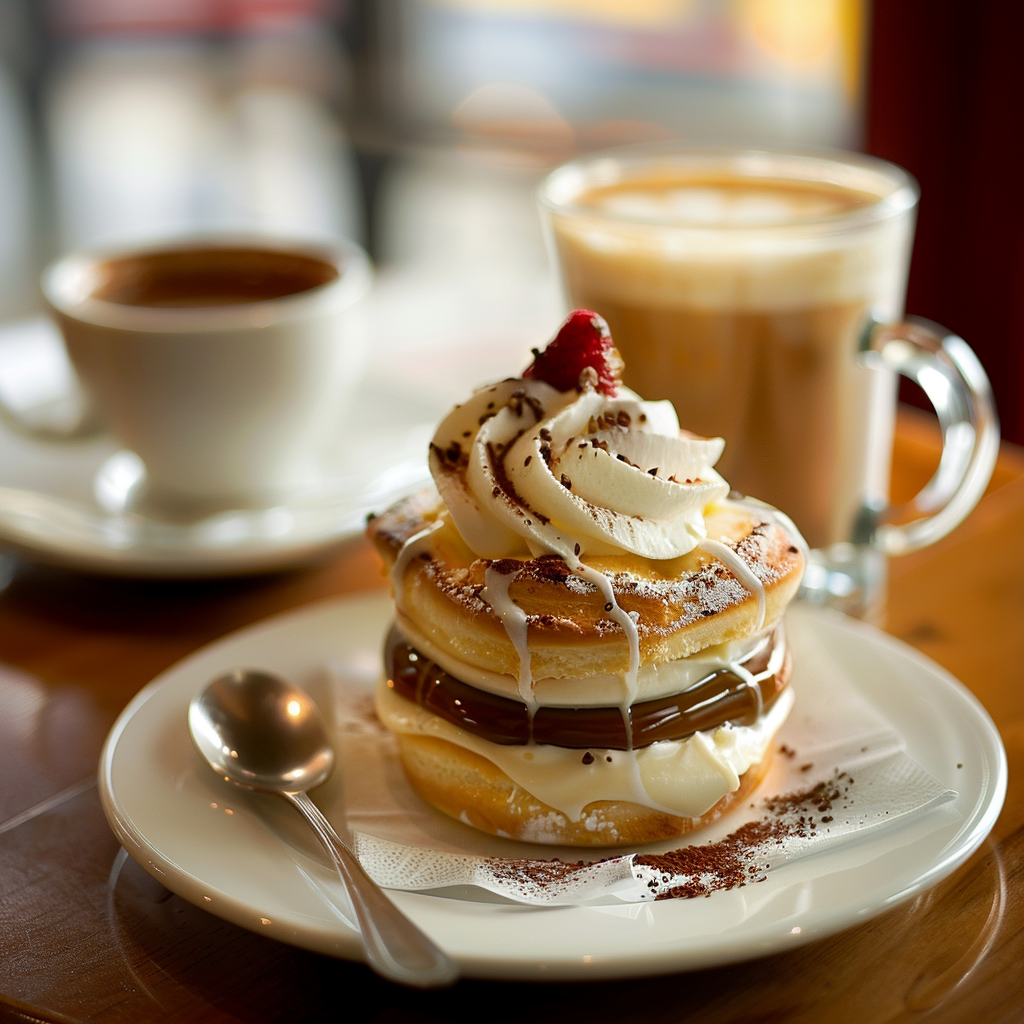
Imagine you’re flipping through a photo album. When you’re taking pictures of cafe treats, it’s not just about snapping a shot of a latte or a croissant. It’s about mixing the yumminess of the food with the vibe of the coffee shop. You want to take pics that make people drool and think, “I gotta try that!” It’s all about making folks feel like they’re right there, about to take a bite.
Changes in Food Photos and Their Value for Coffee Shops
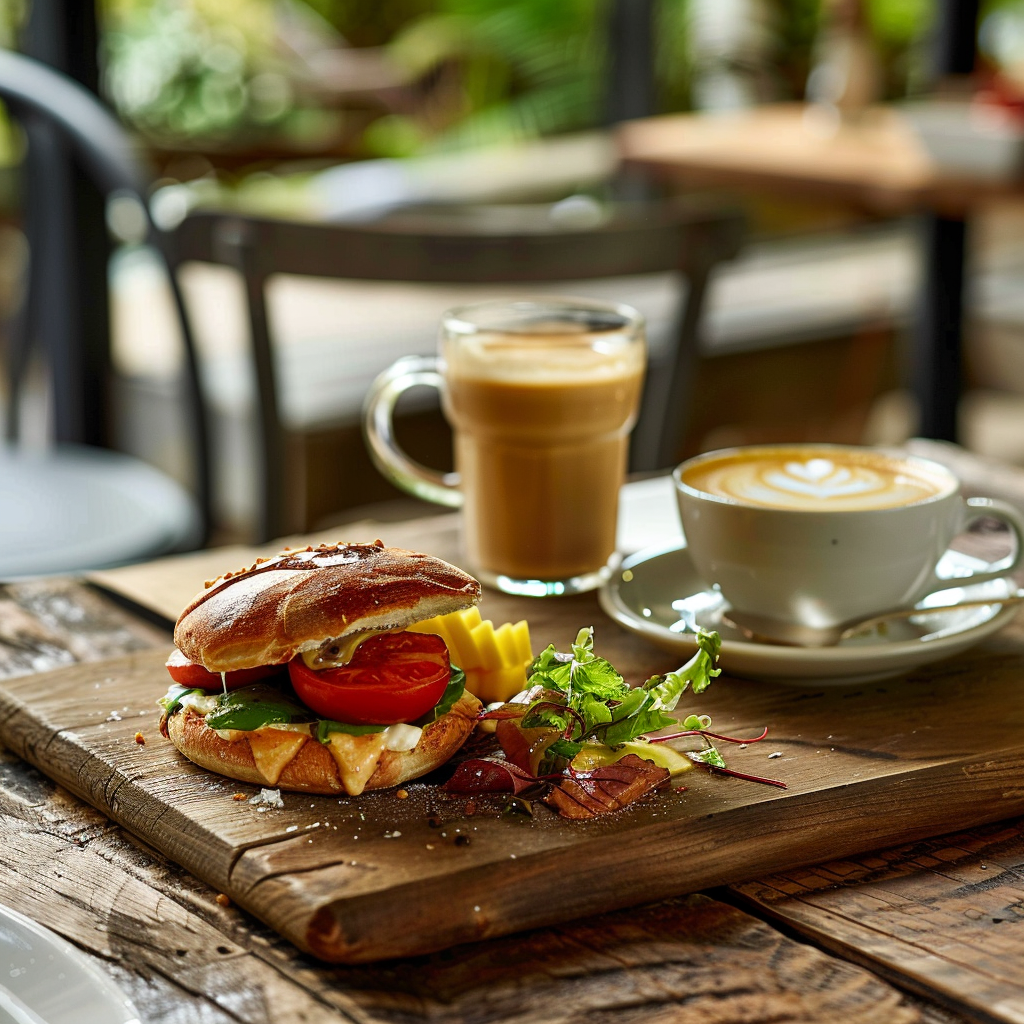
Food photography has transformed from simple pictures to a significant art form, revolutionizing how coffee shops promote themselves. Nowadays, striking photos act like beacons, pulling in culinary enthusiasts who’ve probably seen these images online or in ads. These pictures are crucial—they’re usually the first thing customers see before they even walk into a cafe.
Overview of the Book’s Approach and Structure
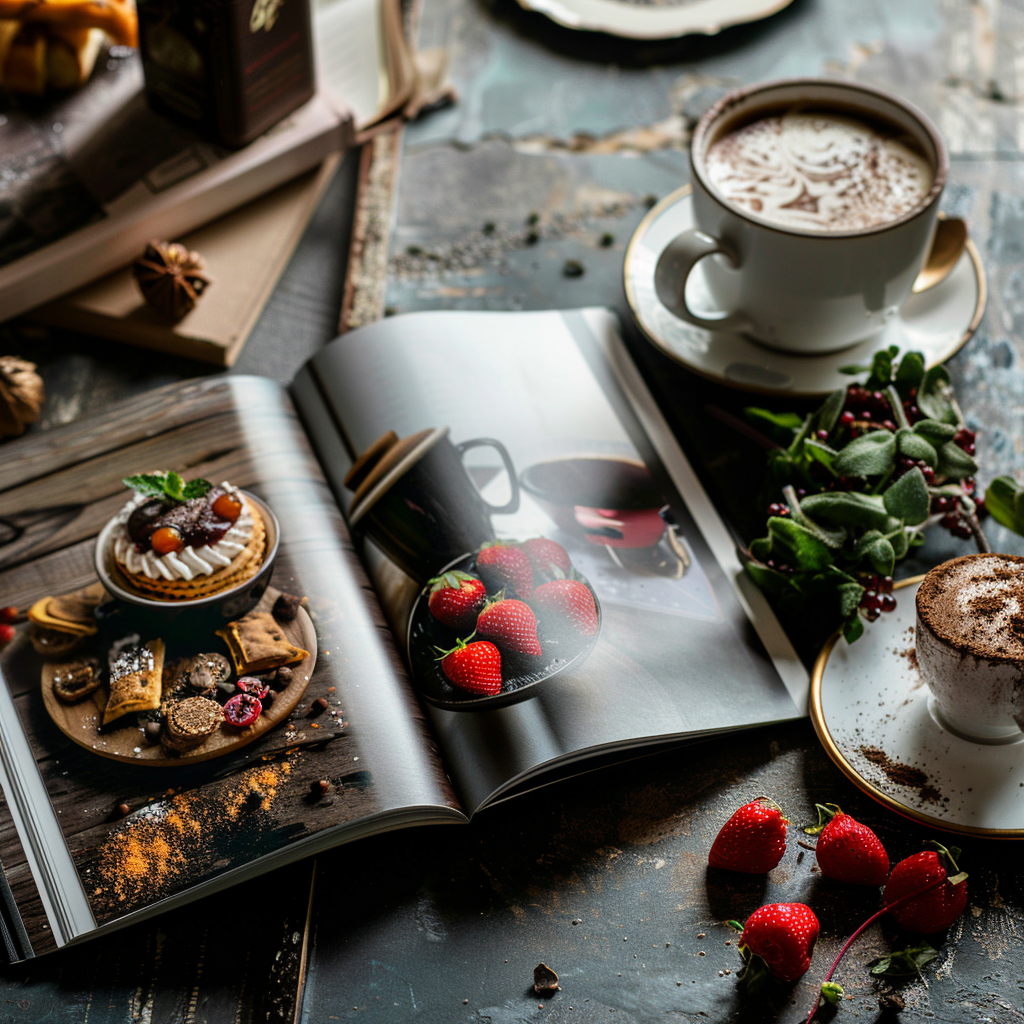
We’re going to dive into this subject step by step. Starting with the basics, we’ll move onto more complicated tricks and styling strategies. Along the way, you’ll get hands-on tips and lots of examples that make the important stuff stand out. Each chapter is laid out to help you get better and smarter at snapping pics of cafe food.
Taking Photos in a Cafe
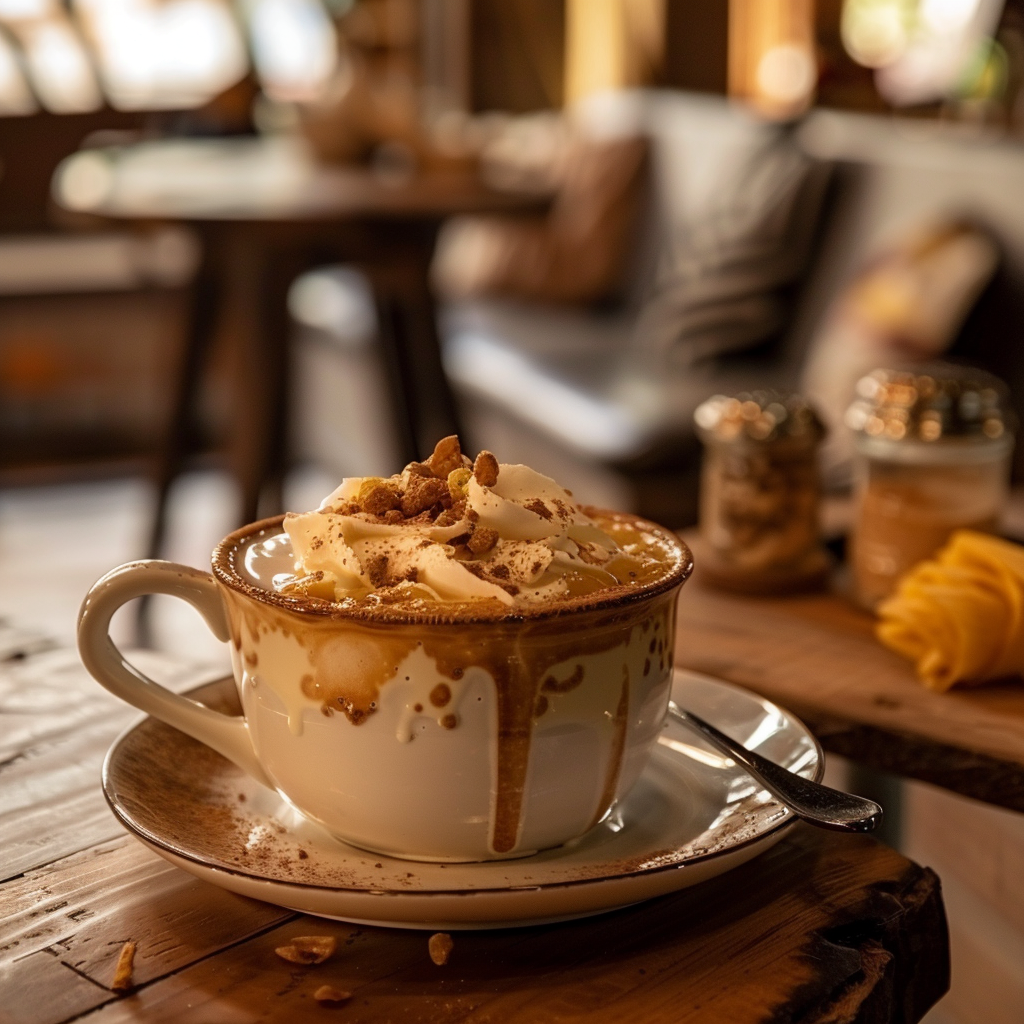
If you want to show what makes a cafe special, it’s important to look at the overall vibe, not just the food and drinks. Telling a story through pictures is about creating a feeling that pulls people into the cafe’s unique atmosphere. Look at the little things: how the tables feel, the design on the dishes, or how the light comes through the window. This way, your photos will connect with others and give them an idea of what it’s like to hang out in this cozy spot.
Snapping the Cafe Feel
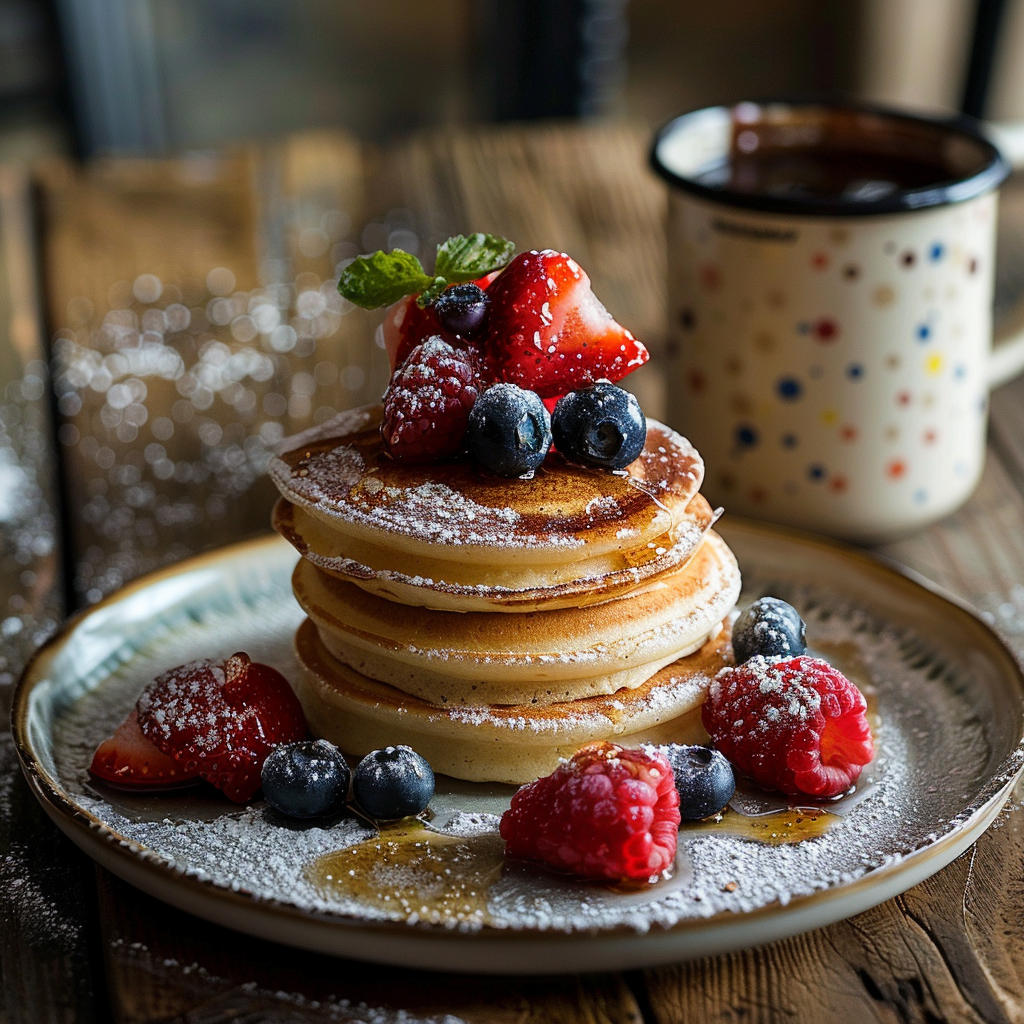
When you’re taking pictures of a cafe, your goal is to capture its soul and vibe. It’s not enough to just take pictures of the meals. You should think about how every detail adds to the sense of warmth, coziness, or buzzing creativity. Use sunlight or play with shadows to highlight different features and add richness. Throw in some shots of people chatting or a worker making coffee in the background. These small bits give your photos life and tell a story. They make people see themselves there, savoring the experience.
Sharing a Story With Food and Scenery
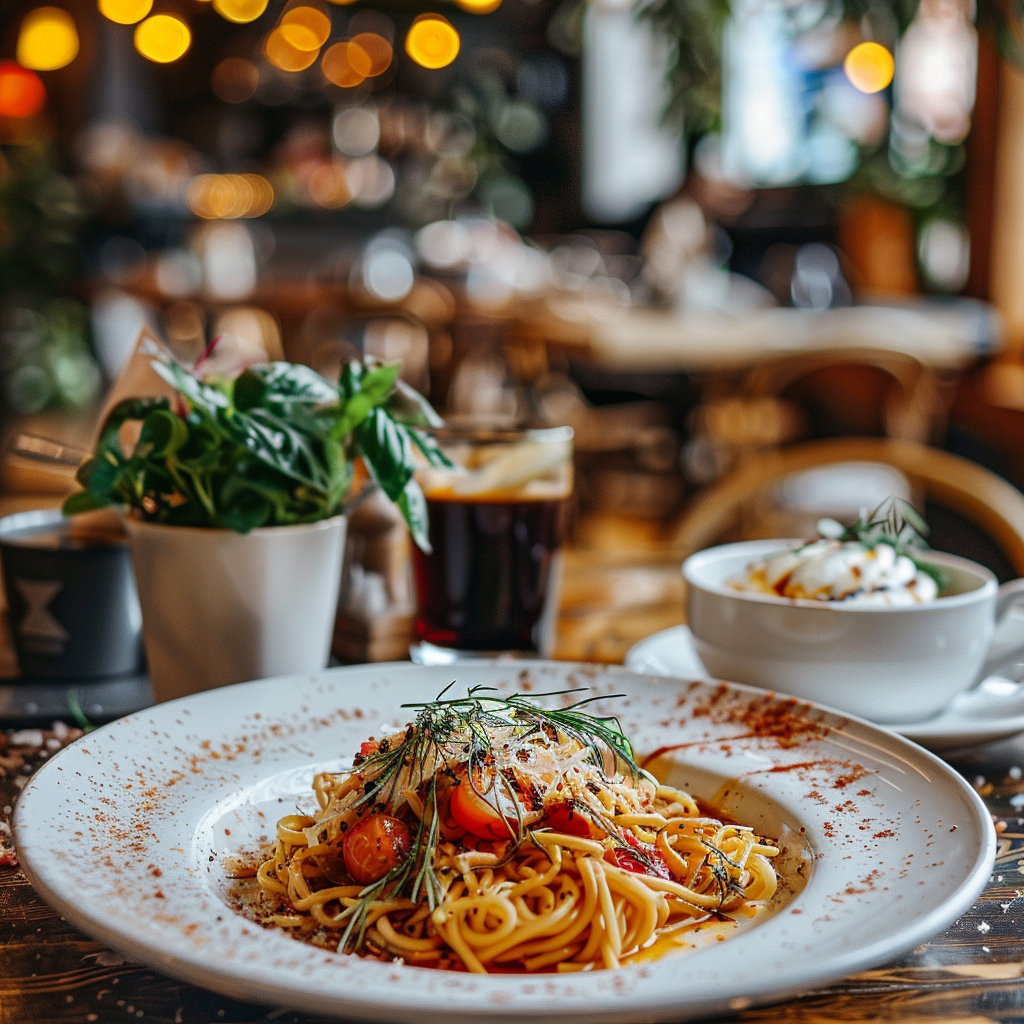
Cafe photography is an art that combines elements of food and setting to tell a story. You can’t just show off a meal; you have to express what it means for the cafe’s style or cultural context.
Imagine a delicious pastry served with an old-fashioned teacup that makes you think of Paris, or a wholesome loaf of sourdough set against a wall of bare bricks that hints at traditional craftsmanship. Creating these visual stories involves careful arrangement. Every item, from crumbs to coffee beans, helps paint a picture of the cafe’s allure.
Understanding Lighting in Cafe Environments
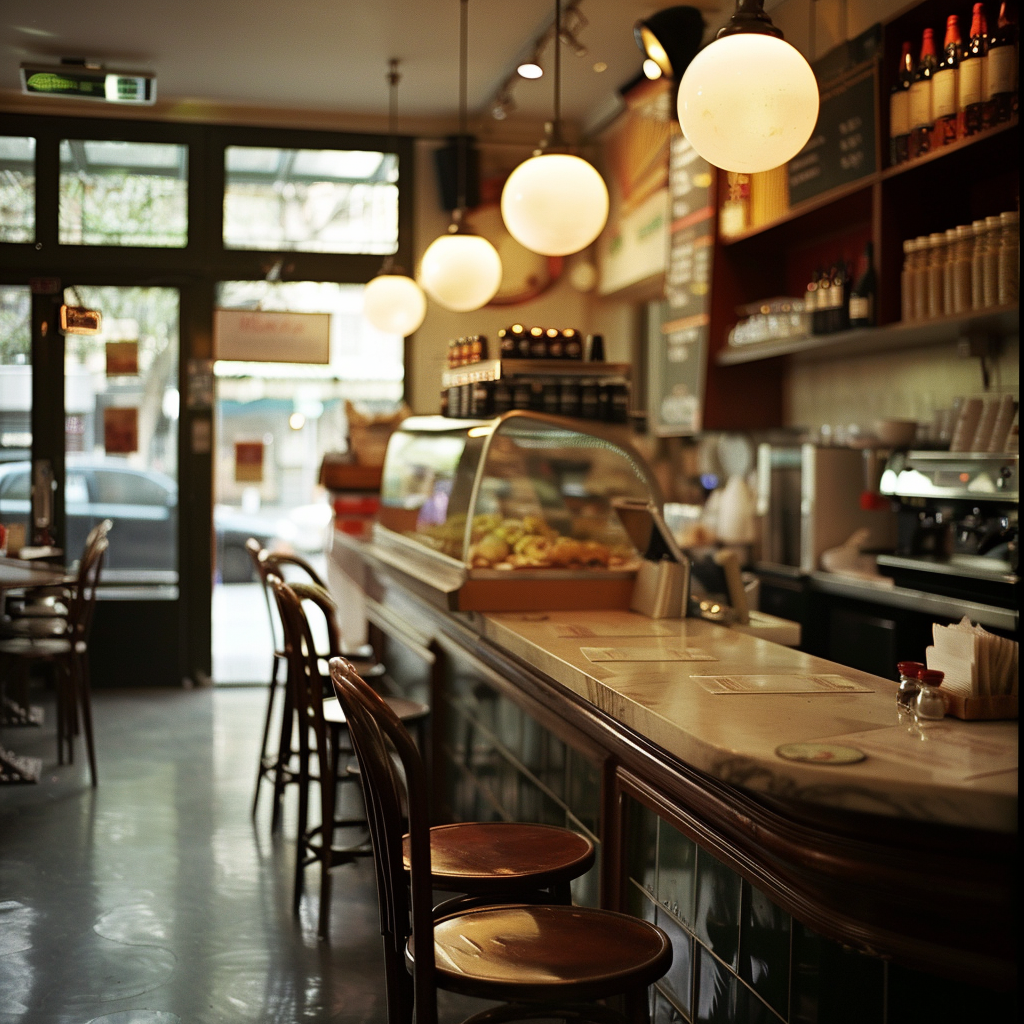
Knowing how light affects your photos in a cafe is key to taking great pictures of food. Cafes usually have big windows that let in plenty of natural light, giving off a soft and warm look that’s great for photos. But, it’s important to stay away from direct sunlight since it can create sharp shadows and make your photos too bright.
Try to put your plate close to the window while keeping clear of the strong sun during lunchtime so you get a nice, gentle light on your food. Using the cafe’s lights can be tough because they can vary in color and brightness.
For better control, consider carrying a small LED light that lets you change its color warmth to blend well with the cafe’s own lights. Watch out for any annoying shadows or glare, and play with different angles and how far or near you are to get the right spread of light on your dish.
Choosing the Right Camera Settings and Lens for Food Photos

Picking the correct camera settings and lenses is very important. Using a wide aperture, for instance f/2.8, you’ll highlight your food because it makes the backdrop blur nicely. Yet remember, your shutter speed should be quick, at least 1/60th of a second, to avoid any blur from your hands shaking or things like steam coming off hot food.
You should keep your ISO low, usually around 100 or 200, to keep your photos clear and not grainy; but if there’s not enough light, feel free to increase it. It’s best to use manual or aperture priority mode so you have better control.Different lenses matter too. A standard 50mm lens is great for food shots, but if you want to catch small details that look really appetizing, go for a macro lens.
You might not think of using a telephoto lens in a small space like a cafe, but it’s useful for squishing elements together in the photo and making the background even fuzzier.
How to Take Better Photos in Cafes
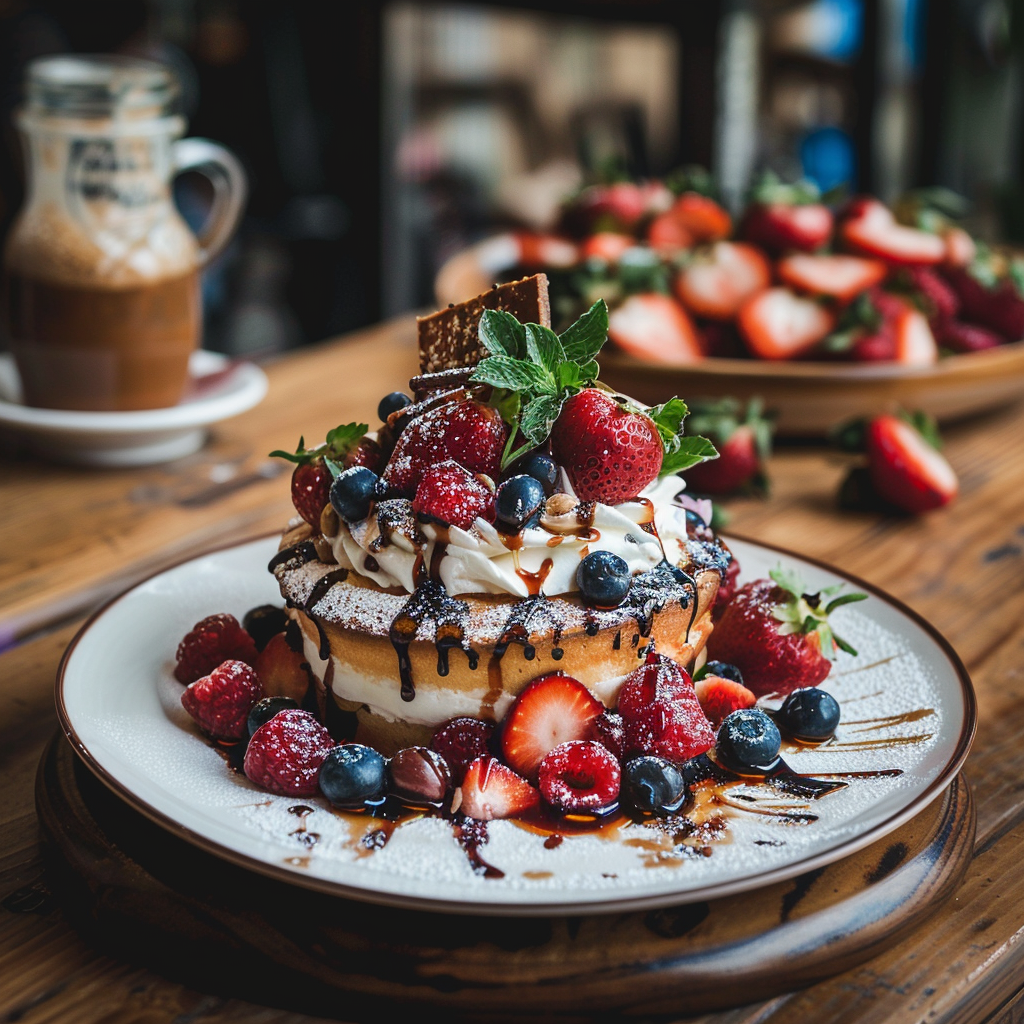
When you’re taking pictures in cafes, here’s what you need to know.
Rule of Thirds: This old standby means picturing your shot split into nine parts by two horizontal and two vertical lines. Try to put interesting parts of the cafe scene where those lines cross.
Leading Lines: Cafes have lots of natural lines – like the edges of tables or the tops of counters. Use them to point people’s eyes to the main subject, which is usually the food.
Layers and Textures: A cafe’s look is already cool, so add things like rough wood tables or fun plates to your photos to give them more feeling and life.
Negative Space: Don’t crowd your picture; keep some open space to make the important stuff – the food – stand out more.
Oh, and always check for random reflections on glasses or silverware before taking a bunch of photos from different sides. And don’t forget, stuff like forks and napkins can help show off your meal in its café setting.
To sum it up, getting good at snapping pics of cafe food means knowing how to work with light, adjusting your camera just right, picking out the perfect lens, and getting your framing down pat. Plus, you gotta make sure that it all fits with the feel of the cafe to really capture those yummy moments perfectly.
The Role of Food Styling in Cafes
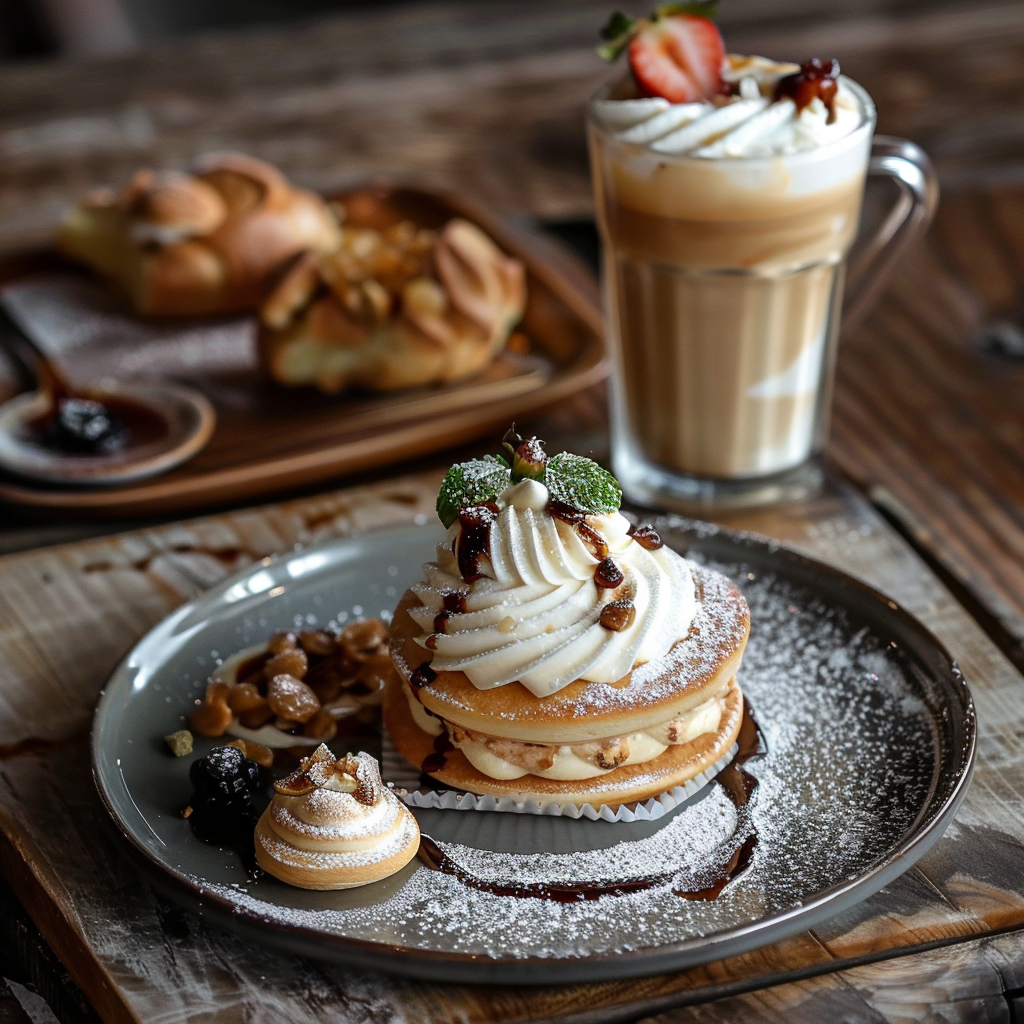
Food styling is crucial for how cafes present and market their dishes. It aims to make the food look so tempting that customers can’t help but want to taste it. A well-styled dish turns ordinary ingredients into something beautiful, emphasizing the different textures, colors, and shapes that make the food stand out. These days, with the importance of online images, cafes need eye-catching photos to grab attention on the internet.
Props and Tableware for better Cafe Food Photography
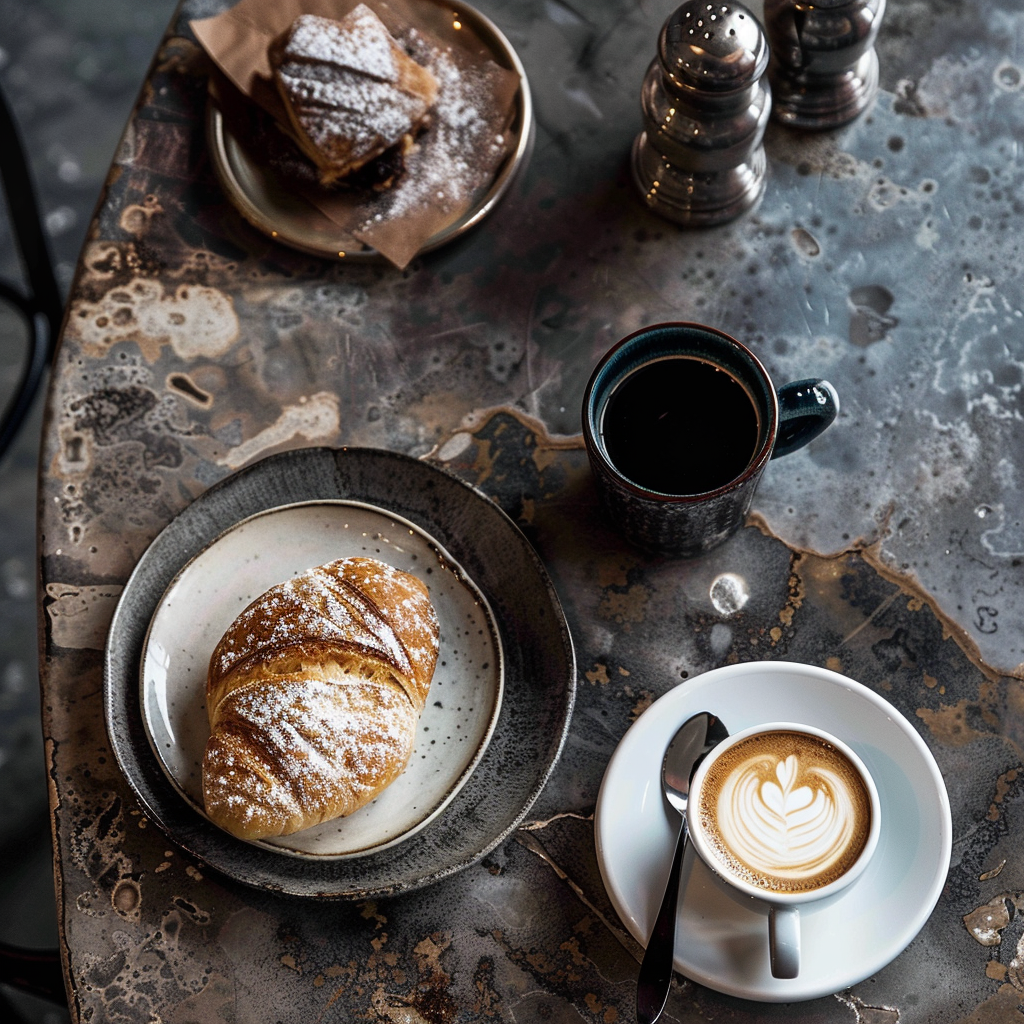
If you want your cafe food pictures to stand out, paying close attention to little details makes all the difference. The right props and tableware can transform a simple photo into something that tells a story.
Imagine using old-fashioned cutting boards, antique silverware, or handcrafted cloths – these bits and pieces give your image more layers and a sense of place. The plate or bowl you choose is important too; it frames your dish and sets it off. A good match can make your photo, but the wrong choice could spoil the whole look.
Striking a Balance: Genuine and Good-Looking
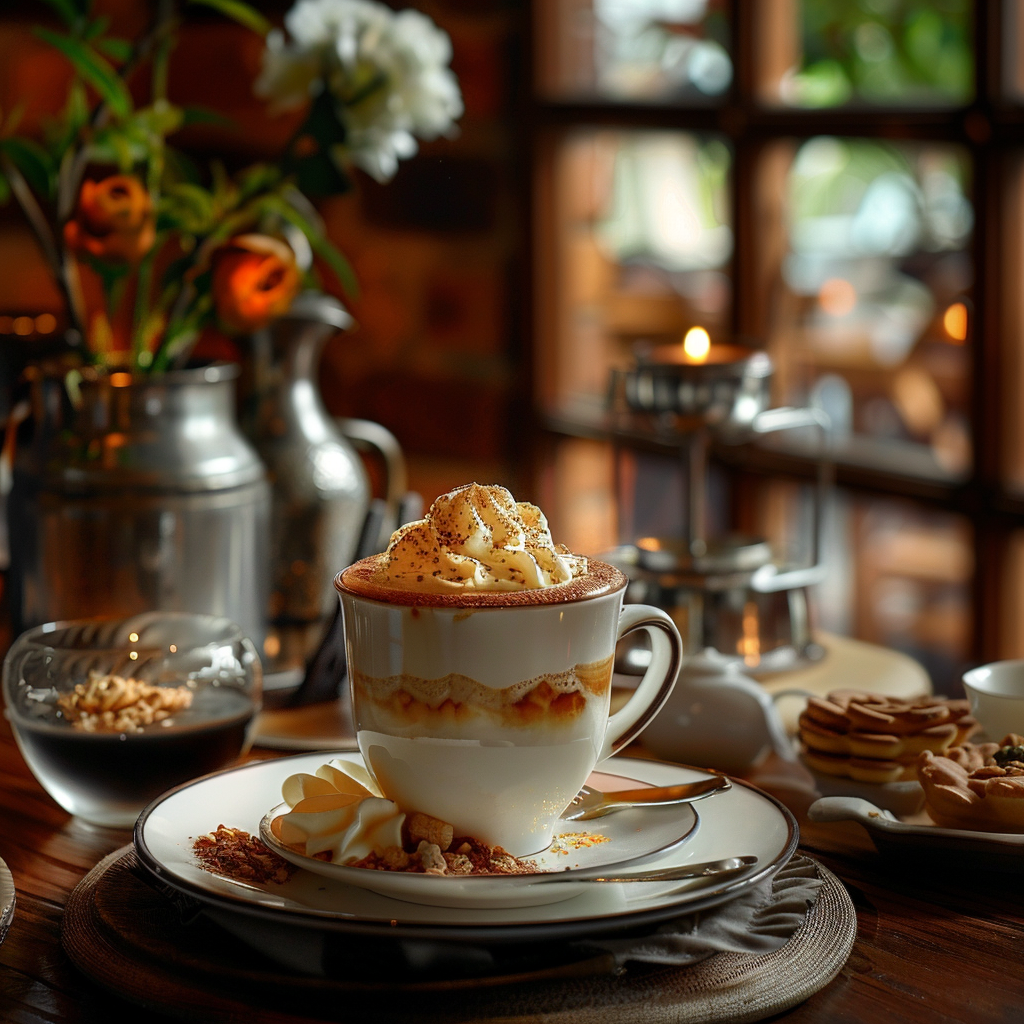
It’s crucial to keep it real when you’re gunning for that picture-perfect shot. You’re aiming for that middle ground where your dish looks gorgeous but still seems genuine. Of course, you want your croissant to glisten and tempt with its flakiness, but if you doll it up too much, it’ll look fake.
People count on getting what they saw in the photo when their meal hits the table; it’s all about hitting the mark where it looks good but recognizably matches what’s actually served.
How to Edit Food Photos
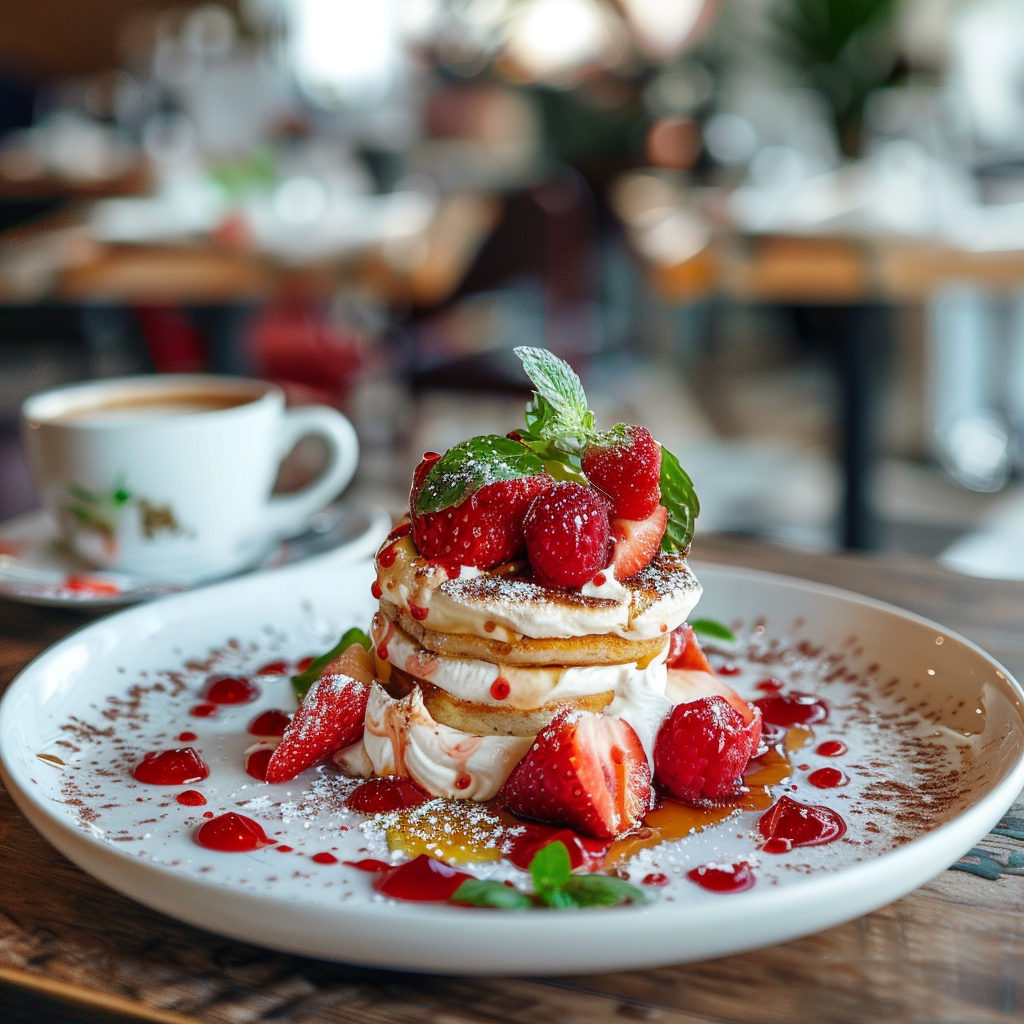
After taking pictures of your restaurant dishes, it’s time to touch them up. Start the simple edits by loading the pictures into software like Adobe Lightroom or Photoshop. Fix the lighting so it’s not overly bright or dim. Alter the contrast to highlight colors and textures, just don’t go overboard. A touch of sharpening can bring out more details in the food.
Modify the white balance to show off the dish’s true colors. At times, fake light can give weird tints to your subject, so fixing that keeps the food looking yummy. Changes to saturation and vibrancy can make the colors better, but aim for a natural and tempting look instead of something that seems fake.
Step Up Your Café Food Photography Game
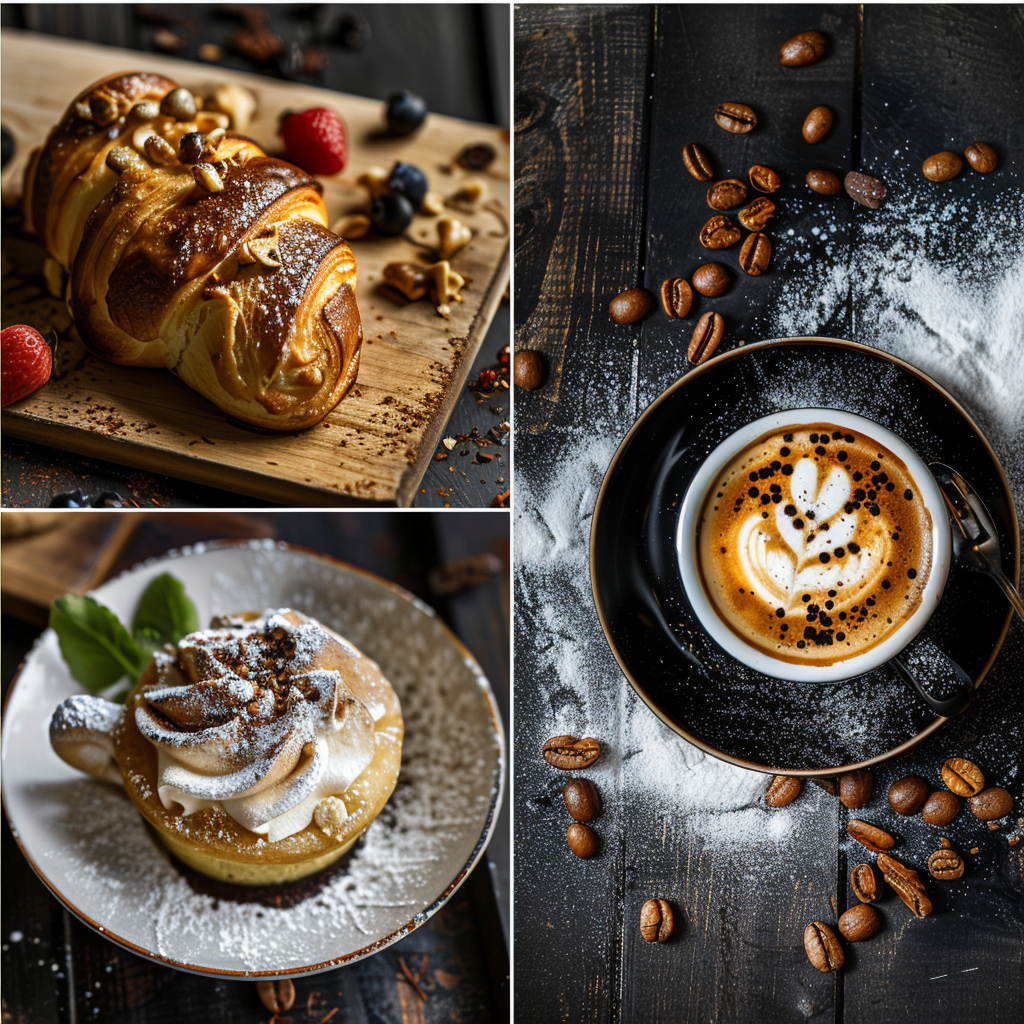
If you’re ready to go beyond simple tweaks, try some complex tricks to make your café food pictures more captivating. When some parts of your photo need emphasis, use targeted adjustments. In Lightroom, brushes allow you to apply changes just where you want them. This way, you can brighten up a dull area in an otherwise great photo or make sure the star of the dish stands out.
In Photoshop, layer masks are handy for adding filters and effects to chosen spots. To create a dreamy background that lets your main subject pop with clarity, play around with lens aperture or use blur effects later on.
The Dodge and Burn tools can add punch by lightening or darkening areas, bringing out detail and giving a sense of dimension to your photos. But be careful—if you do too much, you might end up with a shot that looks more fake than fabulous.
Keeping a Steady Style in Photo Editing
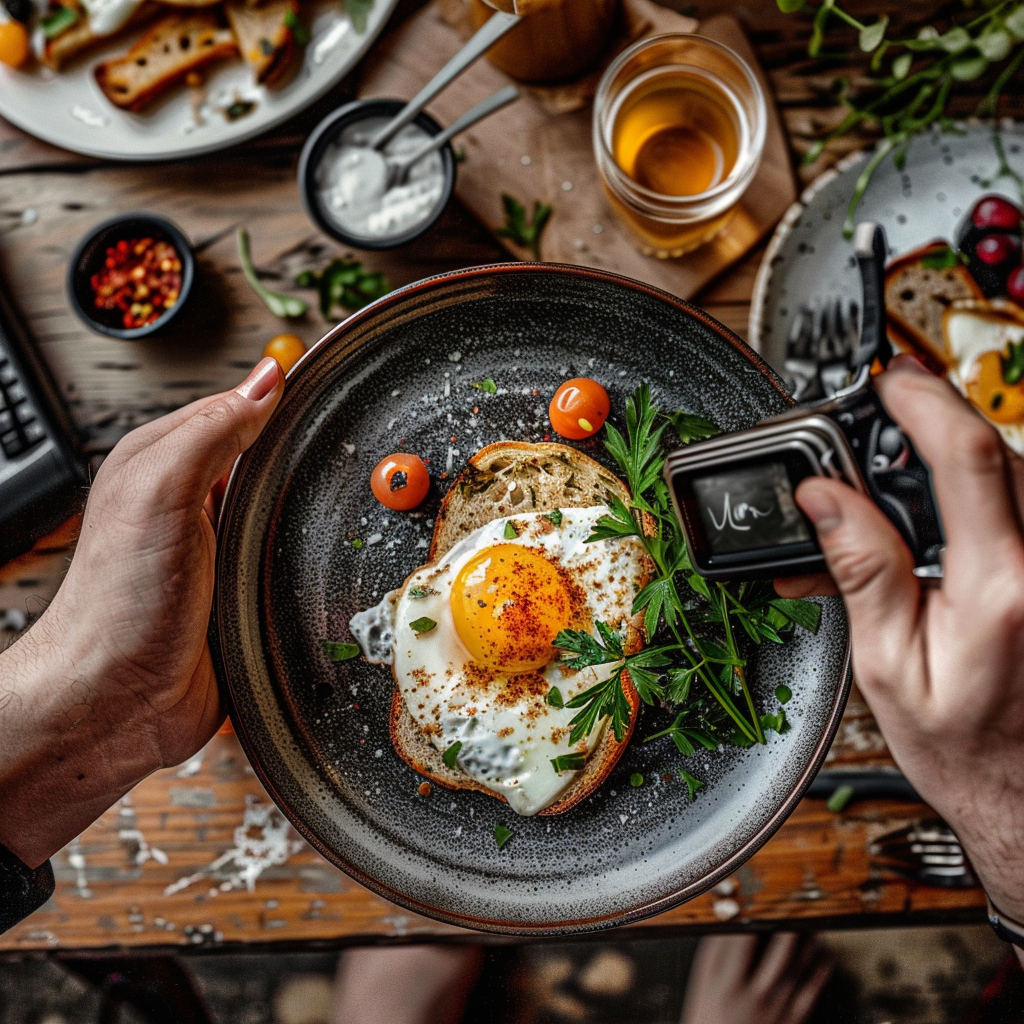
Having a uniform approach to editing is crucial for a unified look, particularly for managing the online image of a coffee shop. Begin with the use of presets or personal base settings that are constant in your editing program. With these, you can uniformly apply essential edits to all photos before fine-tuning them individually.
Pay attention to color tint, warmth, and vividness across every picture. This commitment to uniformity will make your set of photos look polished and professionally linked, instead of just thrown together with varying looks and feels.
To achieve this steadiness, consider making a list of editing steps you always follow. Watch the histogram for consistent exposure to prevent dark areas from losing detail or bright spots from being too glaring. Understand that it’s fine to go back and make changes. As you get better at editing, reworking old photos can help your portfolio maintain a modern and harmonious look.
Make Your Photos Work on Social Media
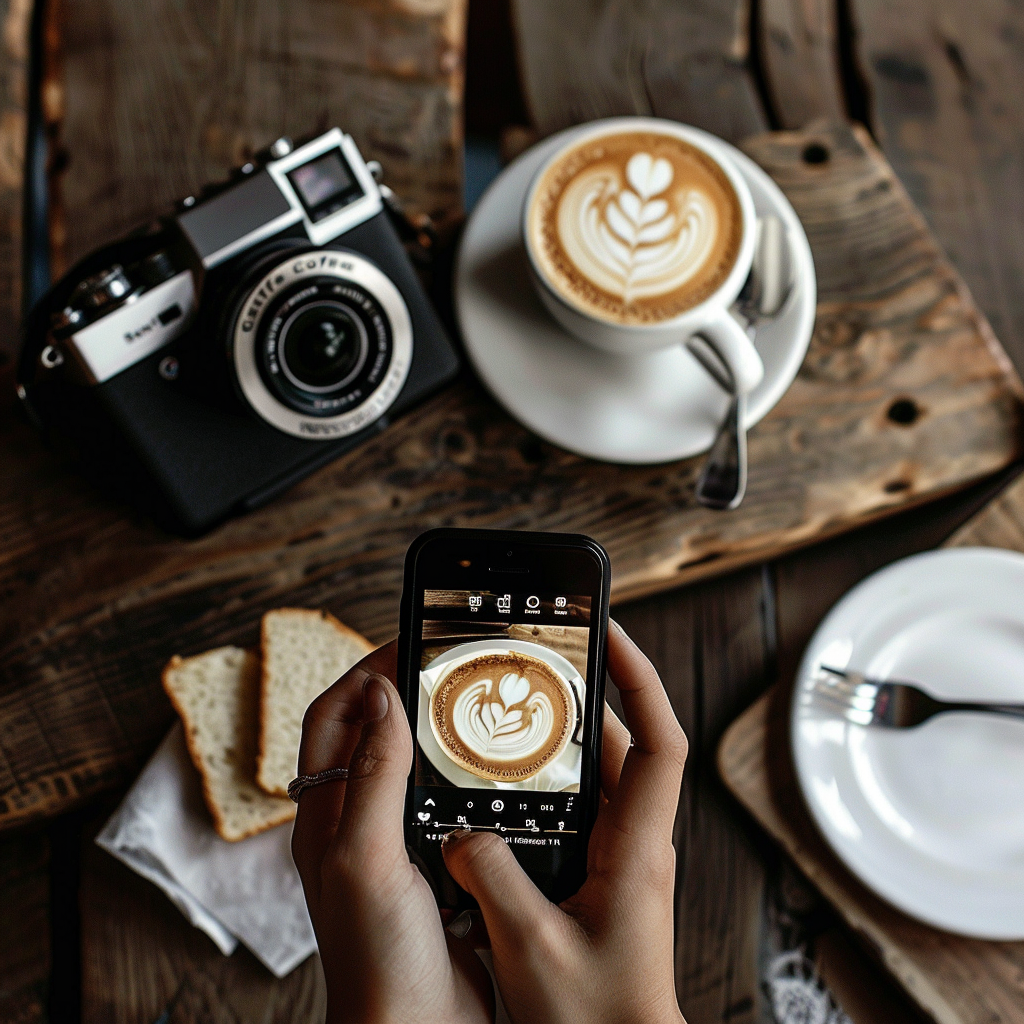
When you’re showing off cafe food online, make sure your pictures fit each social network’s style. On Instagram, clear pictures that are square or tall show off the food’s details. Facebook likes good-looking photos too, ones that make people want to talk or share.
Twitter is all about quick attention—go for bright colors and simple designs to stand out. Pinterest loves long pics with words on top, since they get shared around more in its world of picture hunting.
Attracting Customers with Cafe Food Pictures
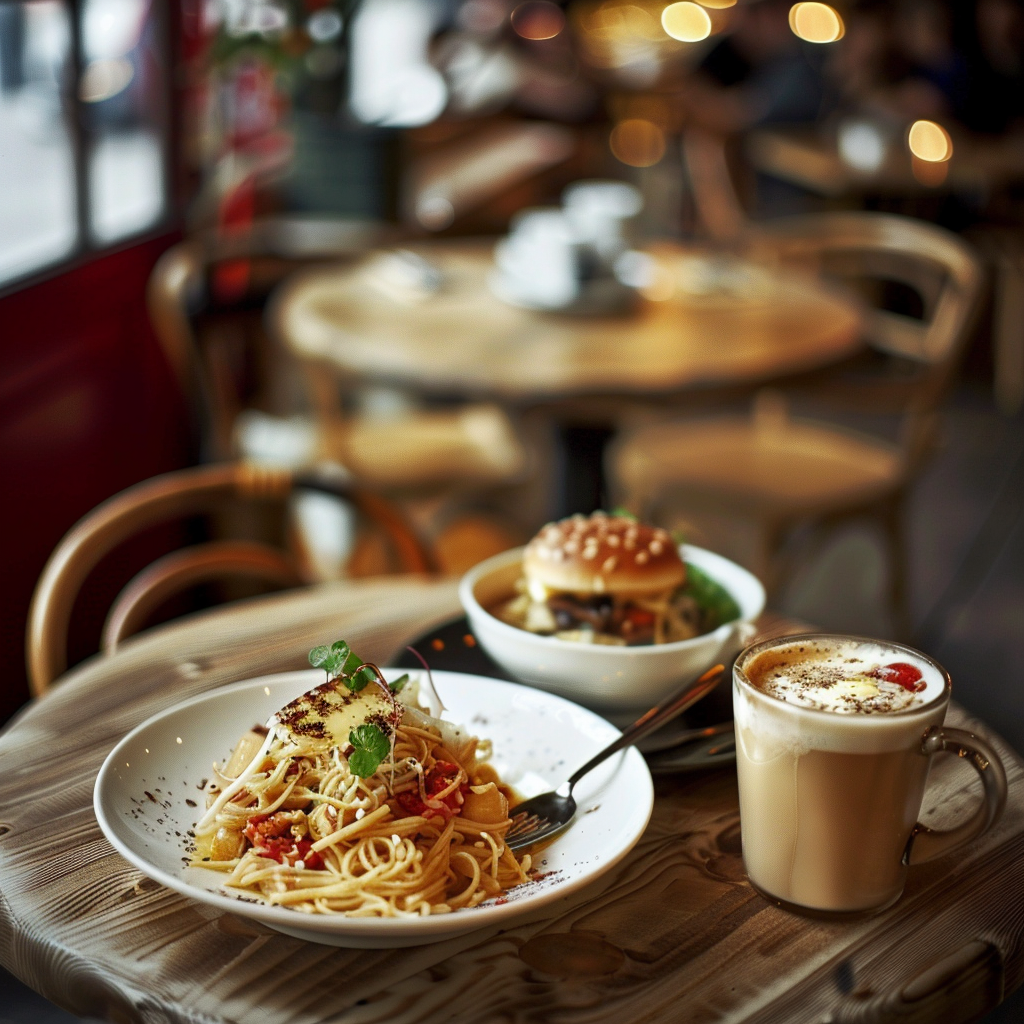
If you want to grab your audience’s attention, you need to do more than just show them what’s on the plate. Try to capture the mood and feelings that come with the dining experience. A photo is really good if it makes the audience feel like they can taste and smell the food.
To get more interaction, ask your followers questions or use phrases that get them to take action. Social media is all about being part of a community, so make sure to reply to comments and keep the conversation going with your posts, as this will help increase how much people interact with you.
How to Gain Followers Through Cafe Photos
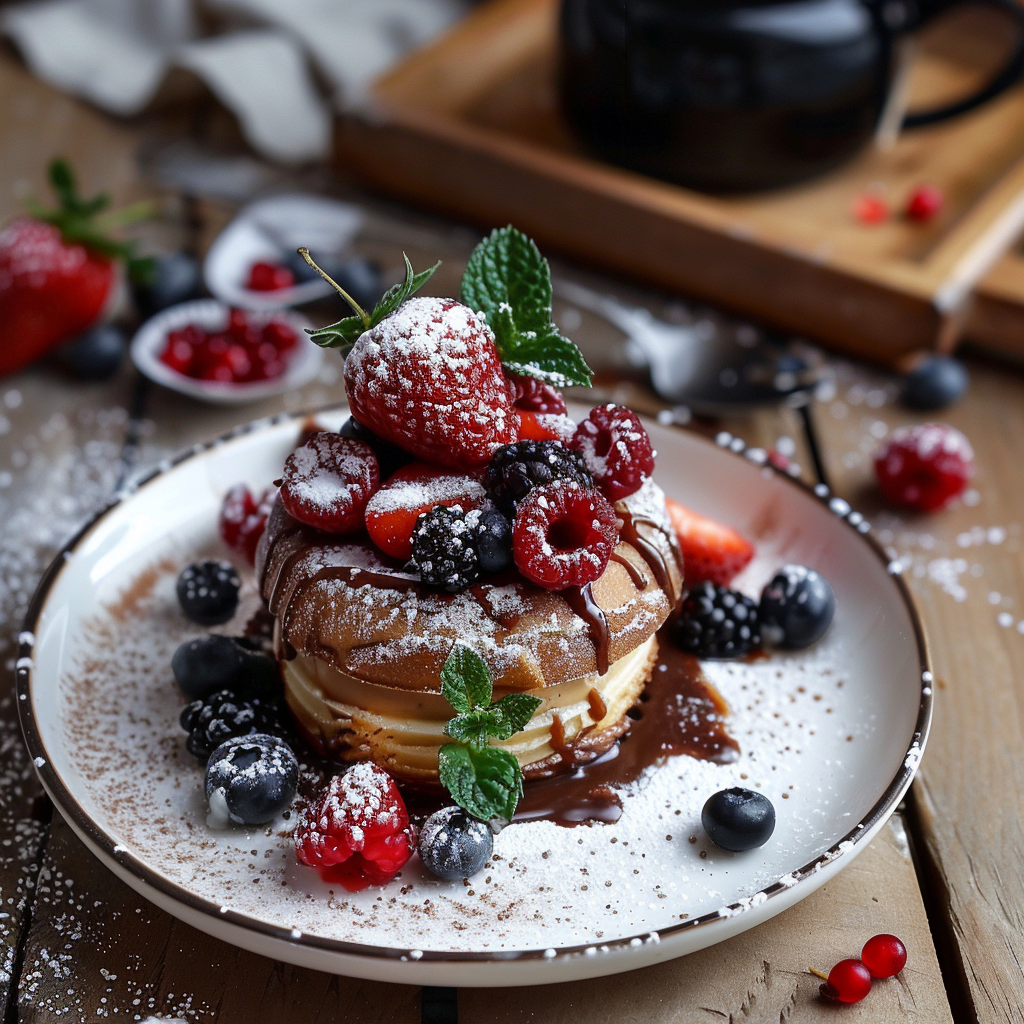
Building your cafe photo following is all about being regular and unique. Post frequently to keep your feed lively and to make your followers look forward to your next post. Stick to a signature style to carve out a recognizable brand.
Also, letting people peek behind the curtain at the kitchen processes or shining a light on special ingredients adds value beyond just pretty pictures. Team up with local foodies or big names on social media to get your photos in front of more eyes.
Choosing the right hashtags for each picture also helps to get noticed by people who dig what you’re serving. Keep an eye on which posts get the most love and learn from that to make your feed even better.
To snap great cafe shots, you need more than a good camera; you need to know the tricks of the trade. Make sure your lighting makes your dishes look mouthwatering, with rich textures and vibrant colors standing out.
The way you frame your photos should tell a story about your food. It’s crucial to respect the bustling life of the cafe – don’t bother the folks enjoying their meal or the staff hard at work. And remember, timing is everything; you want to capture the food when it’s looking its absolute best.
Working with Cafe Owners and Chefs
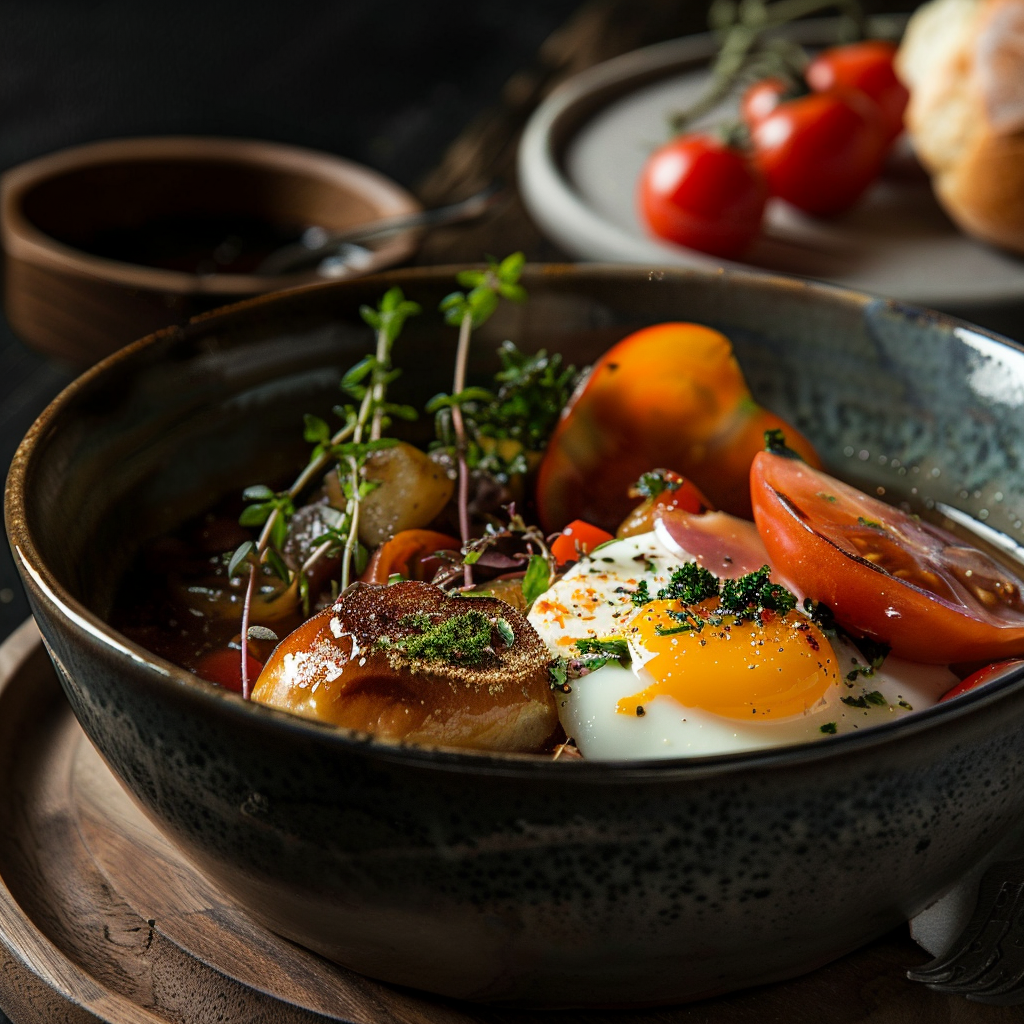
Working alongside cafe owners and chefs can be great, but it’s crucial to talk things through clearly at the start. You’ve got to nail down what everyone wants from the photoshoot right away. Pay attention to what they suggest about which meals should be the stars of the show and get when’s best to stay out of the way during busy hours.
Make it snappy when taking pictures of the freshly prepped food – this way, you’ll get shots that really make people’s mouths water. When you sync up with the fast pace of their world, you end up with pics that truly show off what the café’s all about.
Legal Considerations in Food Photography
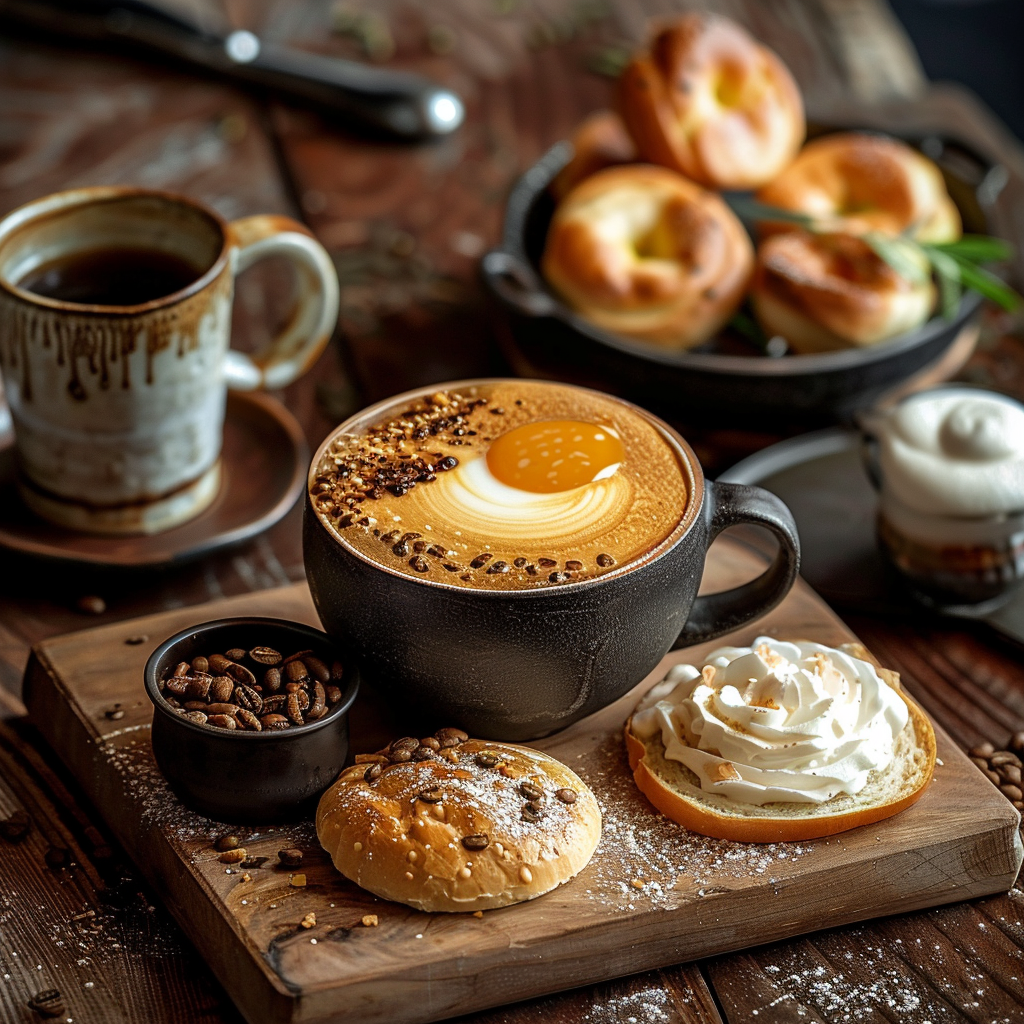
Understanding the legal side of food photography is crucial to protect your work and honor the source. Always get the café owner’s go-ahead before taking photos. Talking it out works, but having a written agreement is better for everyone involved. Watch out for copyright rules.
Make sure your photos are unique, and steer clear of any café logos or patterns that might cause trouble. If your pictures mainly show people, make sure you have their written consent before posting or printing them.
Building a Portfolio and Pitching Services

To draw in customers, you really need a solid portfolio. Make sure to display a mix of food types, settings, and designs. Show off the work that best represents your personal style in photography.
As you approach potential coffee shops, customize your offer to match their vibe, demonstrating how your photography could boost their image.
It’s important to be good at networking, so be active in making contacts with nearby businesses and get involved in local happenings. Consistently reaching out with skill can open doors for you.
The Latest in Cafe Food Photography
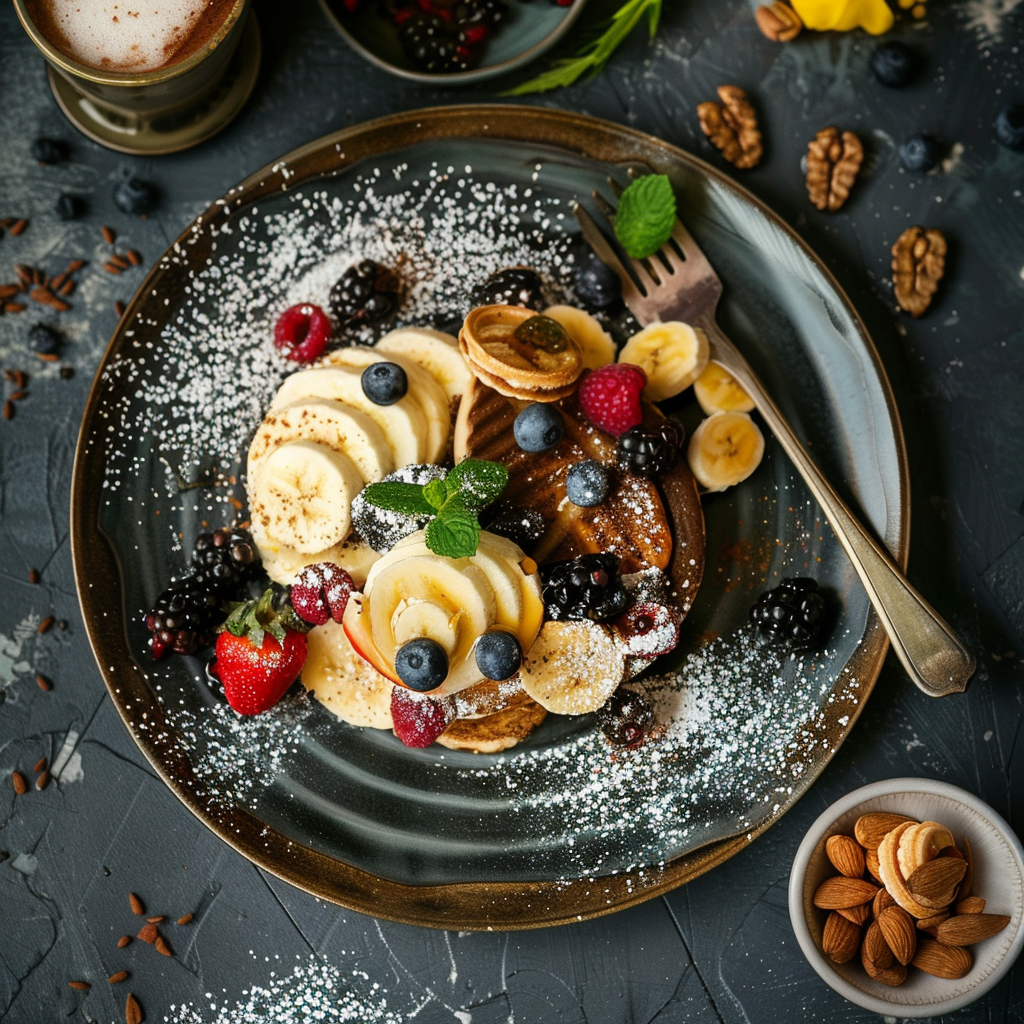
Cafe food pictures have changed a lot lately. Now, folks prefer using natural light because it makes the photos look softer and more welcoming, really showing off the food’s natural color and texture. It’s all about keeping it real; the pictures capture the true vibe of a cafe and what it’s serving up.
You’ll notice less clutter, too, with a focus on just the dish, so nothing else takes your eye away. Telling a story with the photo is big – like giving a nod to where the food comes from – this gives a whole new layer of meaning to what’s on the plate. And one more thing – pictures are starting to show a bit of action, like drizzling syrup on pancakes, to make things feel alive.
New Methods and Rising Tech Trends
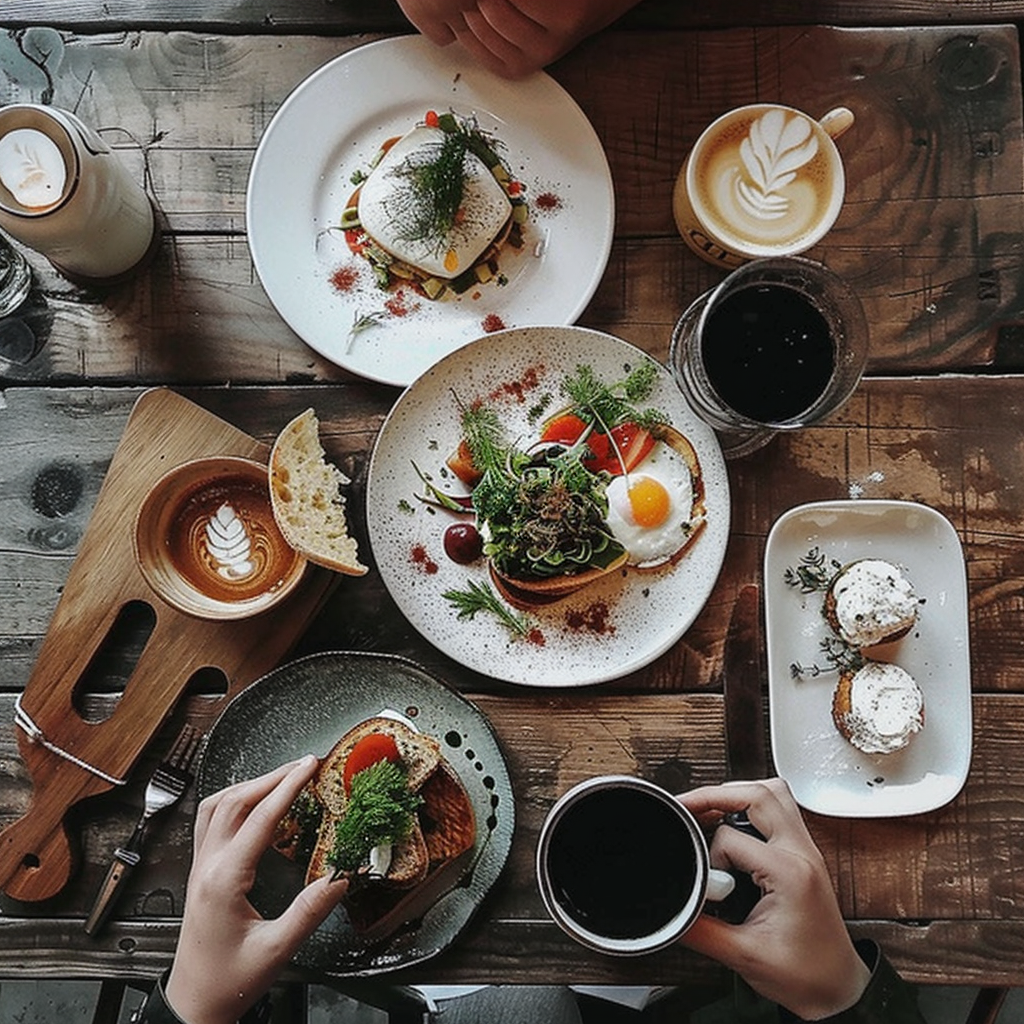
Food photographers are trying out lots of new tricks to improve their pictures. They’re using macro lenses for super close-up shots that show off the food’s texture. Edit tools help them adjust the colors and make the picture really stand out.
Drones are getting popular for taking shots from way up high, giving a cool different viewpoint. We’ve also got 360-degree photos now, which let you look at the food from all around. And don’t forget about smartphones; they’re getting so good at taking pictures that you can snap pro-level photos wherever you are.
Future Trends in Cafe Food Photography
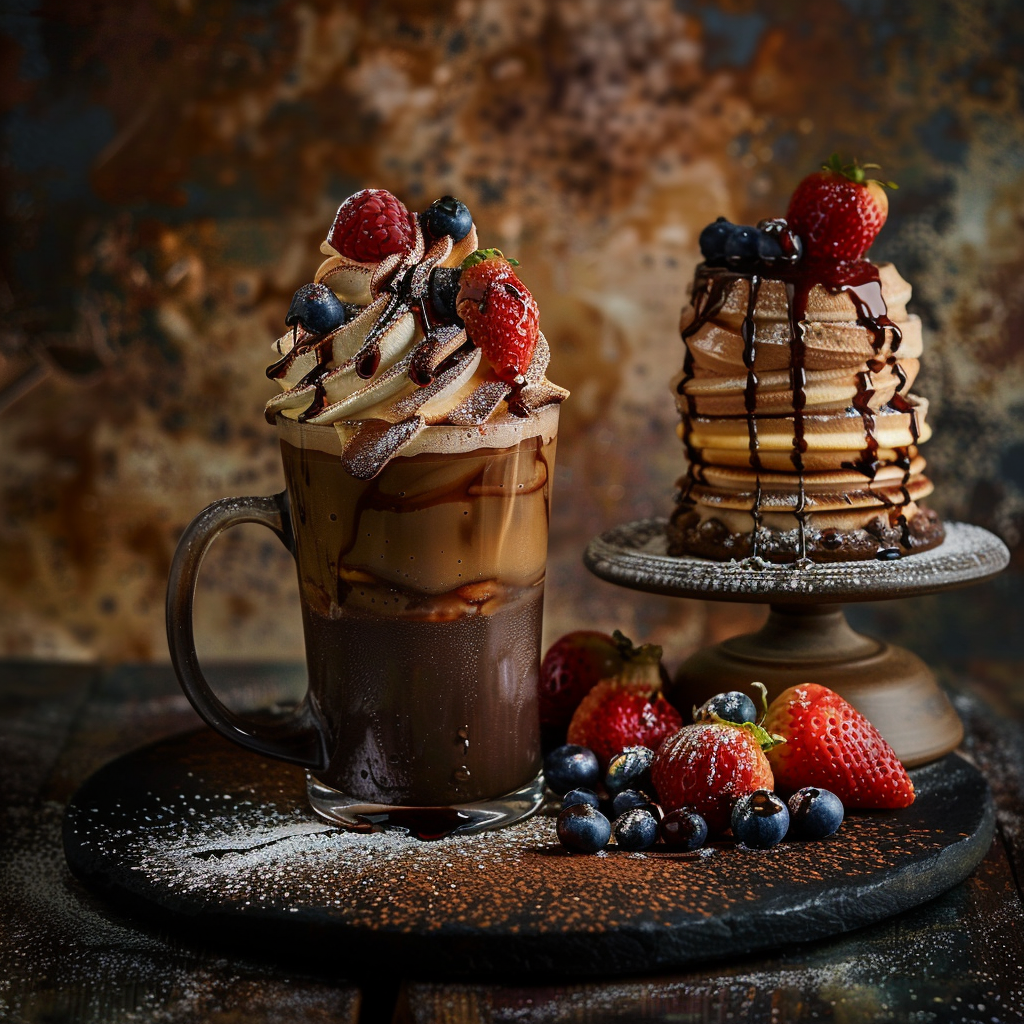
Looking ahead, cafe food photography seems set for a thrilling and tech-savvy future. As social networks grow and change, we’ll see a greater demand for engaging and dynamic images. Features like augmented reality might let customers check out dishes virtually before ordering, and AI could help make the perfect shot with less work from people.
Also, photos will become more personalized, matching what individuals like and their health needs. Plus, as going green gets more attention, we’ll probably see a boost in photos that show off environmentally friendly habits and local produce.
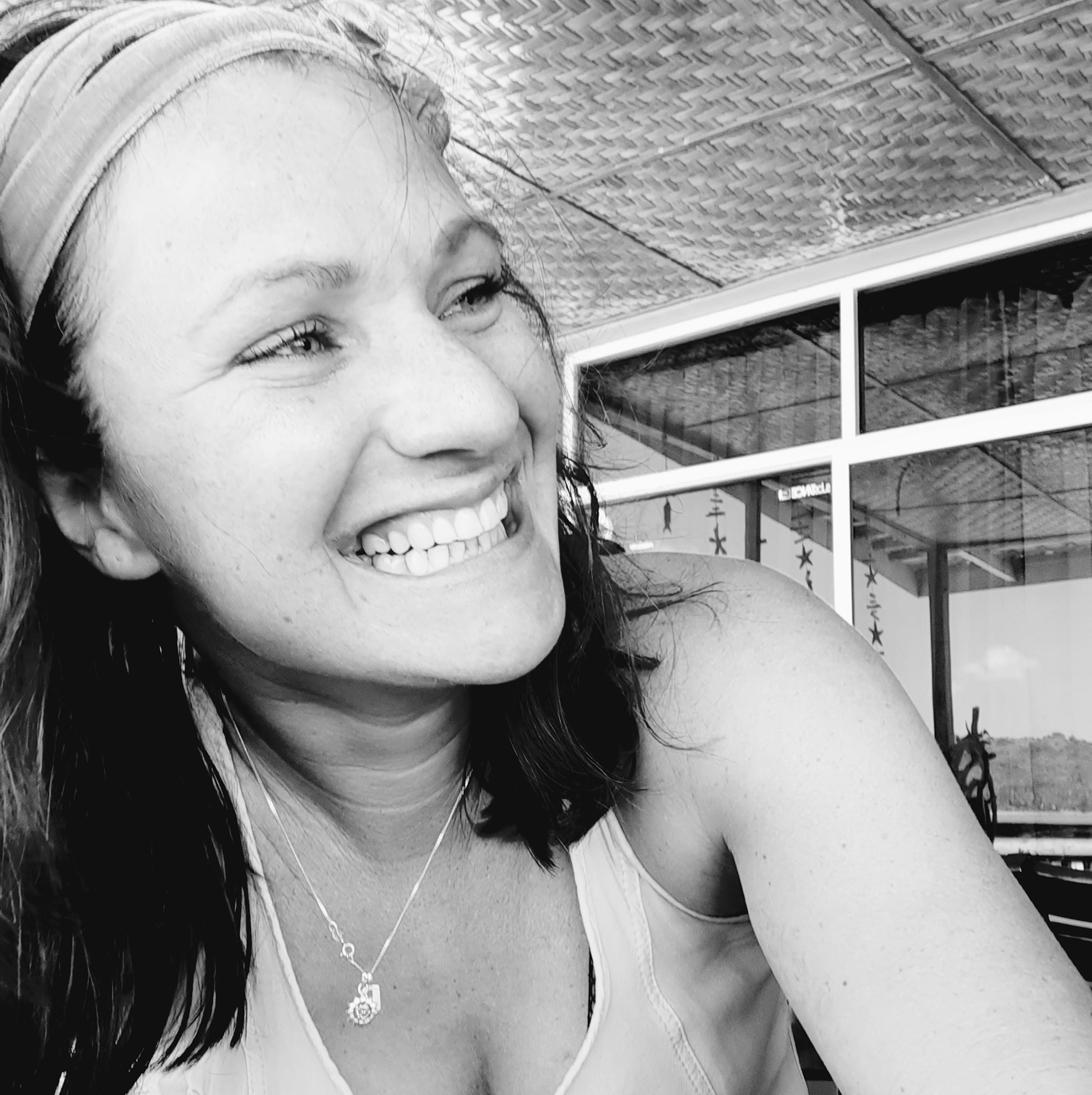
About Author
Rachel Noël is a professional photographer and videographer from the UK with over 10+ years of experience. Rachel specializes in Underwater, Tavel & Portrait photography among other areas.
